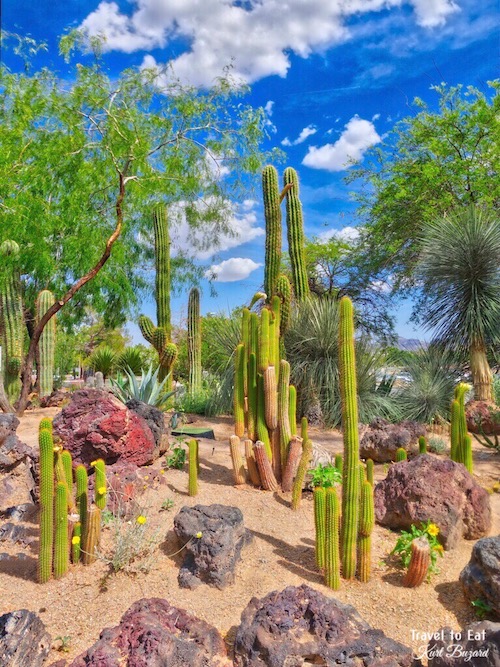
Most people who do not live in a desert environment consider cactus to be an unattractive species. Nothing could be farther from the truth, cactus are a beautiful species, similar to euphorbia in Africa. Euphorbia can be found all over the world. The forms range from annual plants laying on the ground, to well developed tall trees. In deserts in Madagascar and southern Africa, convergent evolution has led to cactus-like forms where the plants occupy the same ecological niche as cacti do in deserts of North America and South America. The genus is primarily found in the tropical and subtropical regions of Africa and the Americas, but also in temperate zones worldwide. The 1,500 to 1,800 species of cacti mostly fall into one of two groups of “core cacti”: opuntias (subfamily Opuntioideae) and “cactoids” (subfamily Cactoideae). Most members of these two groups are easily recognizable as cacti. They have fleshy succulent stems that are major organs of photosynthesis. They have absent, small, or transient leaves. They have flowers with ovaries that lie below the sepals and petals, often deeply sunken into a fleshy receptacle (the part of the stem from which the flower parts grow). All cacti have areoles highly specialized short shoots with extremely short internodes that produce spines, normal shoots, and flowers. In Las Vegas we have one of the best cactus gardens in the world at the Ethel M Botanic Garden.
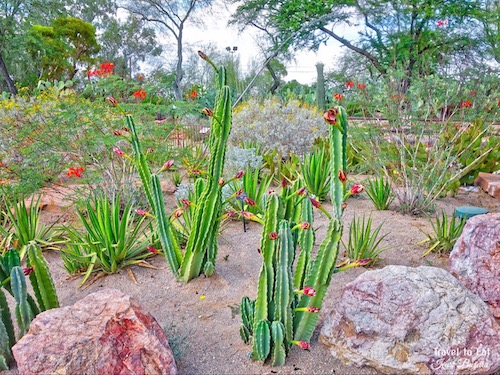
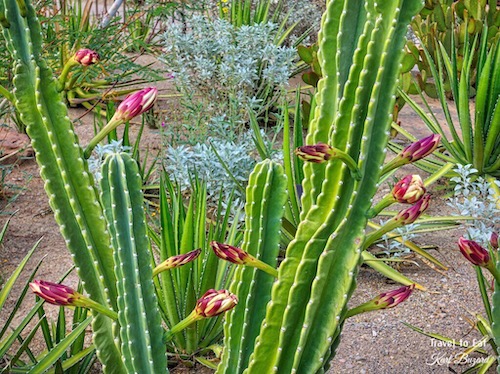
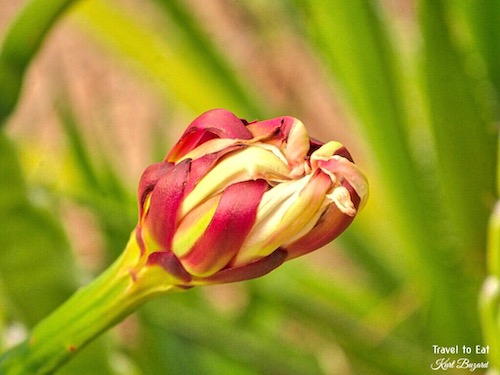
Cereus is a genus of cacti (family Cactaceae) including around 33 species of large columnar cacti from South America. The name is derived from Greek and Latin words meaning “wax” or “torch”. The genus Cereus was one of the first cactus genera to be described, the circumscription varies depending on the authority. The term “cereus” is also sometimes used for a ceroid cactus, any cactus with a very elongated body, including columnar growth cacti and epiphytic cacti. In my mind the cereus cacti are the most beautiful and pure form of cactus. The name Cereus originates in a book by Tabernaemontanus published in 1625 and refers to the candle-like form of species Cereus hexagonus. The 33 or so species that remain in the Cereus group are largely plants that have not been moved out of the genus rather than plants that have been included because they fit the description of Cereus. This inclusion-by-lack-of-exclusion makes for a very messy and unsatisfactory grouping.
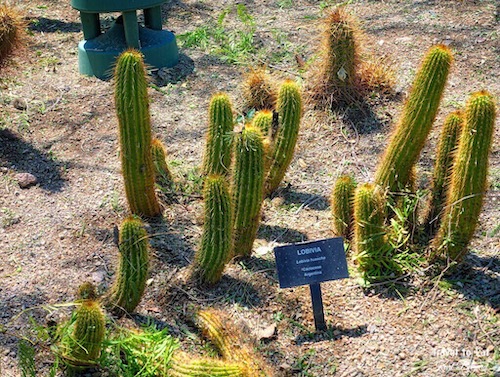
Echinopsis winteriana, better known as Lobivia winteriana is one of the many geographical form of Echinopsis backebergii. Many of its morphological and geographical variant was early classified as different independent species, but nowadays all this plant are considered part of a multiform species, where each form is linked to others by populations of plants with intermediate characteristics. Echinopsis winteriana has distinctive bright fuchsia pink petals that contrast nicely with the with a paler or white throat. It is a very prolific bloomer, if you keep it reasonably cool and absolutely dry during winter. The species is however controversial and is now fully synonymized with Echinopsis backebergii. The Echinopsis huascha is native to north-western Argentina (states of Catamarca and La Rioja), where it grows in semi-arid, rocky and sandy areas, characterized by dry warm climate with both daily and seasonal remarkably wide temperature range, and poor rainfalls concentrated in the summer season.
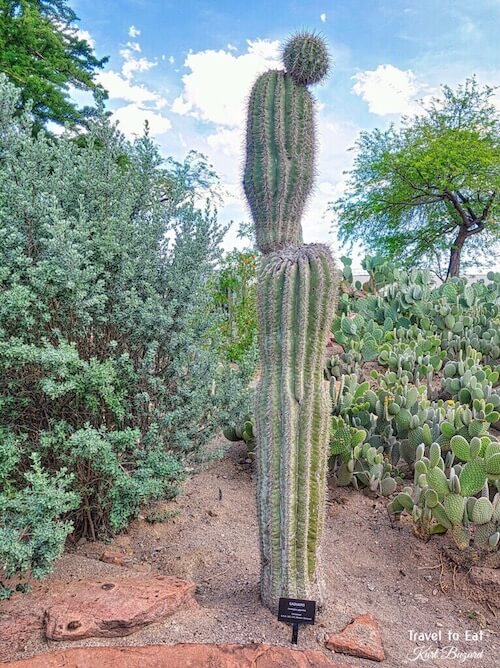
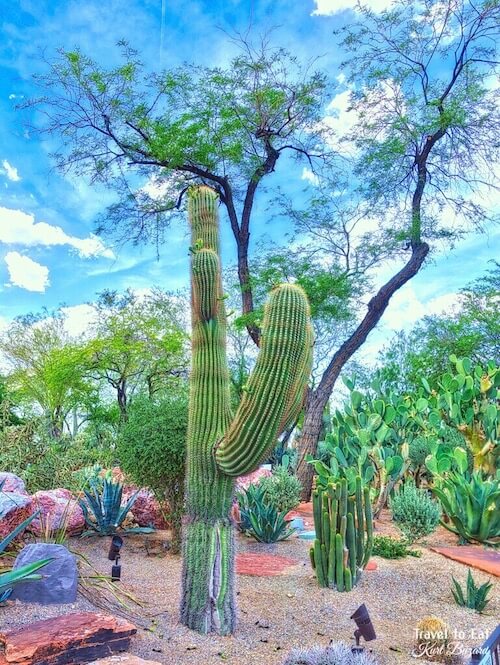
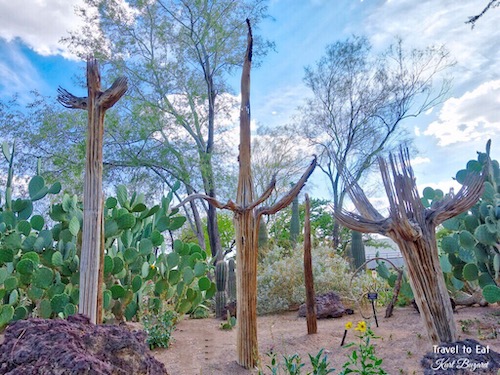
The Saguaro Cactus (Carnegiea gigantea), is composed of a tall, thick, fluted, columnar stem, 18 to 24 inches in diameter, often with several large branches (arms) curving upward in the most distinctive conformation of all Southwestern cacti. The skin is smooth and waxy, the trunk and stems have stout, 2-inch spines clustered on their ribs. When water is absorbed, the outer pulp of the Saguaro can expand like an accordion, increasing the diameter of the stem and, in this way, can increase its weight by up to a ton. Specimens may live for more than 150 years and grow to be over 40 ft tall. The saguaro skeleton is a rare and beautiful sight that is usually the last surviving entity of the mighty saguaro cactus. Notably, the saguaro can live upwards of 150-200 years and is a testament to the long-lasting beauty of the American Southwest; particularly the Sonaran Desert. The skeleton of these captivating cacti; much like the saguaro as it is maturing, can take decades to be completely revealed. They are a rare wonder that sporadically decorate the terrain across the deserts of their natural habitat. Due to their unique look and rare occurrence, people have a fond appreciation of the saguaro skeleton and seek it out as a unique part of their household decor.
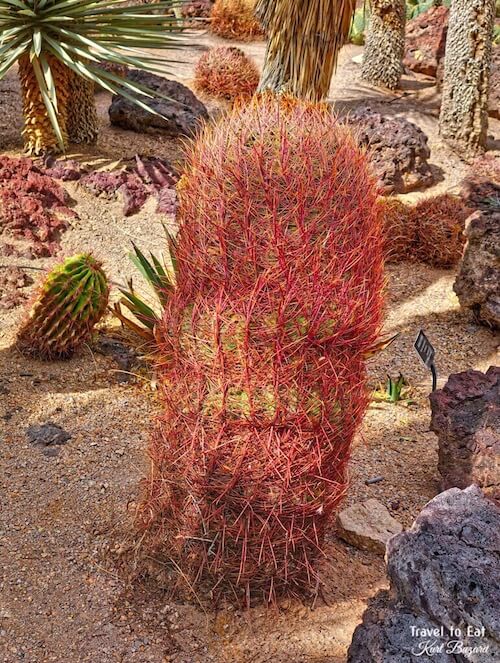
Ferocactus cylindraceus is by far the most widespread of the giant barrel cacti, and is quite variable in spine color – deep red, whitish, yellow, or intermediate shades, but characterized by a long (up to 5 inches), curved central spine that points outwards and downwards and is covered by tiny ridges. Close by are 3 more outward-pointing spines, slightly shorter, and 8 to 28 smaller, lighter colored radial spines, all contributing to a dense lattice that mostly obscures the green stem and its pronounced ribs, numbering 18 to 31. Flowers are yellow, appearing in spring and early summer, while the fruits are bright yellow.
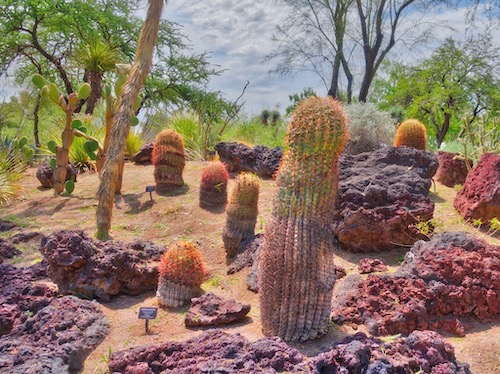
Barrel cactus are various members of the two genera Echinocactus and Ferocactus, found in the deserts of Southwestern North America. Also known as yellow- or even red-spined barrel cactus because the spine clusters contain yellow, as well as reddish, pink and gray spines. There are four central stiff, spines, another series of 4 to 10 stiff spines, then a series of fine wispy spines. The central spine may be strongly curved, but is not hooked. The clusters of spines may be so long and dense that they nearly obscure the stem. There are about 30 species of barrel cactus included in the genus Ferocactus. They are found in southwestern USA and northwestern Mexico. The young specimen are columnar, as they grow older, the ribs get formed and they start taking the typical barrel shape.Most of the species are solitary, but others like Ferocactus robustus and F. glaucescens are clumping.
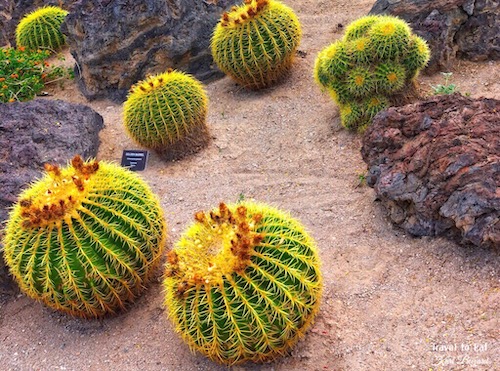
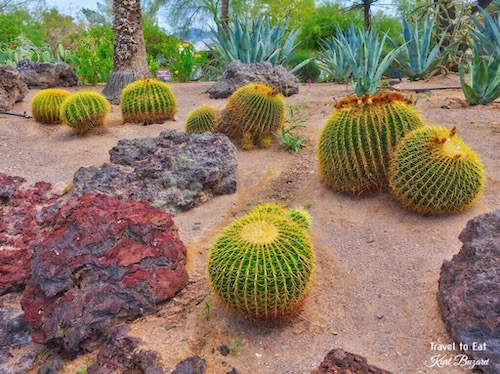
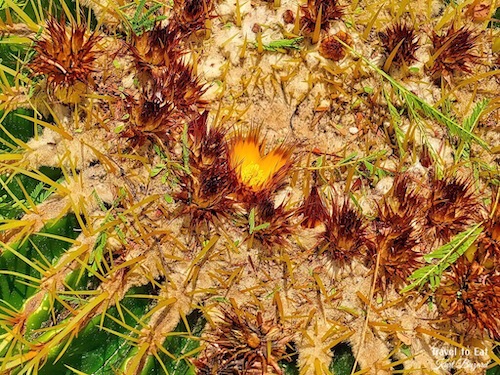
Echinocactus grusonii, popularly known as the golden barrel cactus, golden ball or, amusingly, mother-in-law’s cushion, is a well known species of cactus, and is endemic to east-central Mexico.It is rare and endangered in the wild, where it is found near Mesa de Léon in the state of Querétaro, and in the state of Hidalgo. It is one of the most popular cacti in cultivation. Garden designers Madame Ganna Walskaof Lotusland in Montecito, California, and Jamie Durie of Australia, have considered it a personal favorite. It has increasingly become popular as an architectural accent plant in contemporary garden designs.
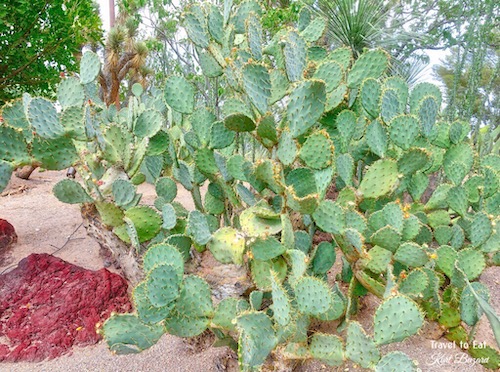
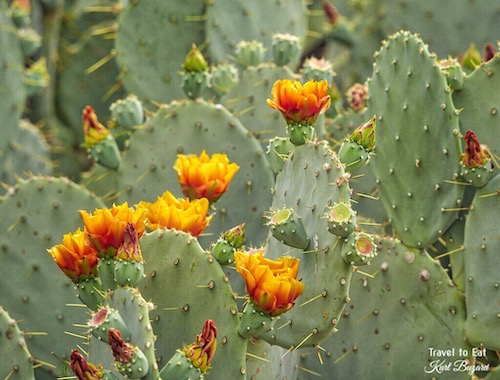
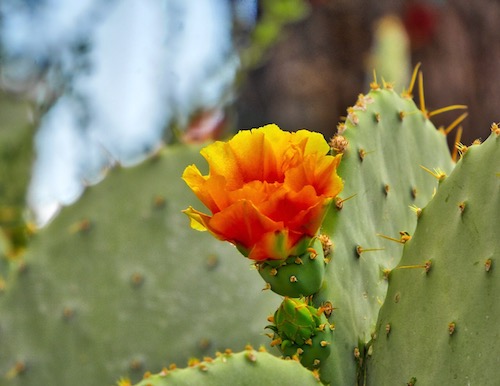
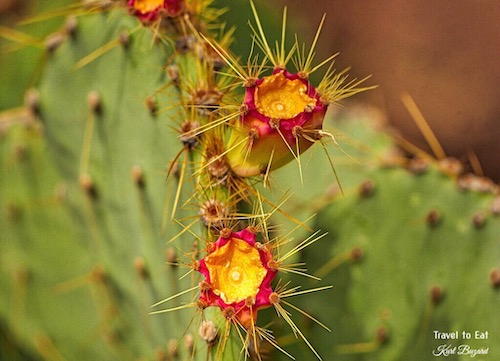
When Carl Linnaeus published Species Plantarum in 1753, the starting point for modern botanical nomenclature, he placed all the species of cactus known to him in one genus, Cactus. In 1754, the Scottish botanist Philip Miller divided cacti into several genera, including Opuntia. He distinguished the genus largely on the form of its flowers and fruits. Like all true cactus species, prickly pears are native only to the Americas, but they have been introduced to other parts of the globe. Prickly pear species are found in abundance in Mexico, especially in the central and western regions, and in the Caribbean islands (West Indies). In the United States, prickly pears are native to many areas of the arid Western United States, including the lower elevations of the Rocky Mountains, where species such as Opuntia phaeacantha and Opuntia polyacantha become dominant, and to the desert Southwest, where several types are endemic. The genus is named for the Ancient Greek city of Opus, where, according to Theophrastus, an edible plant grew which could be propagated by rooting its leaves. Opuntia phaeacantha is a species of prickly pear cactus known by the common names tulip prickly pear and desert prickly pear found across the southwestern United States, lower Great Plains, and northern Mexico. Older names for this species, and names for old species which are now considered variants of this species, include plateau prickly pear, brown-spined prickly-pear, Mojave prickly pear, and Kingman prickly pear.
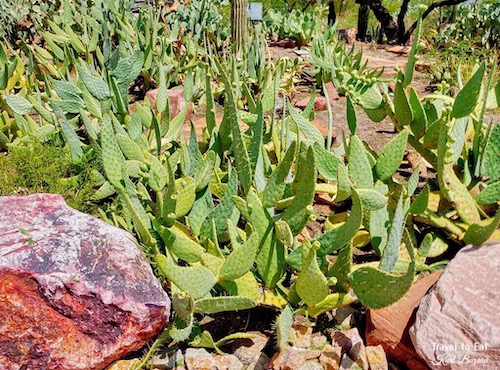
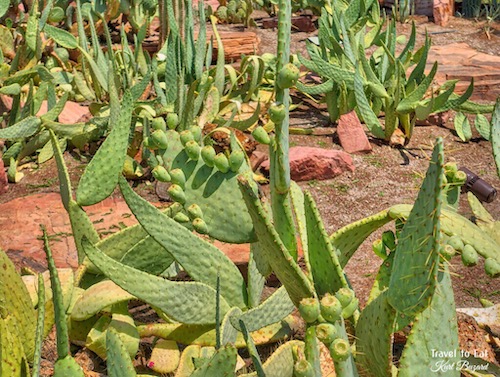
Cow’s Tongue Cactus (Opuntia engelmannii var. linguiformis or Opuntia lindheimeri var. linguiformis) ranges from three to five feet in height. The joints are bluish-green when young and turn yellow to brown with age. They are damaged by insects frequently, however they do regrow from broken pads. The yellow flower is about 3 inches in diameter and blooms from April to June. The reddish-purple, pear-shaped fruit, or tuna, is 1 1/2 to 2 1/2 inches long and covered with small spines. Cow’s Tongue Cactus fruit is eaten by many birds and small mammals, including coyotes. The joints are made edible for livestock by burning the spines off and it is readily eaten in times of drought by many animals.
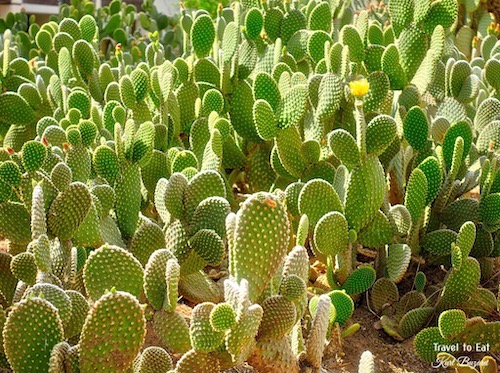
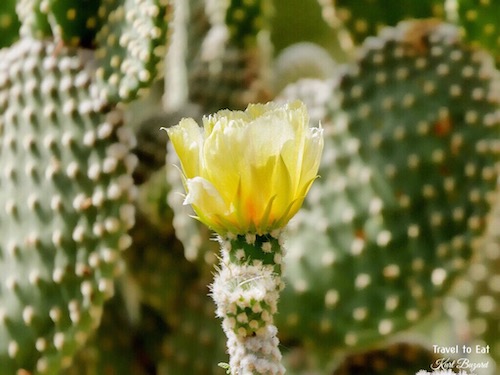
Opuntia microdasys (angel’s-wings, bunny ears cactus, bunny cactus or polka-dot cactus) is a species of cactus native and endemic to central and northern Mexico. The Cactus genus Opuntia is highly variable, hybridizes, and therefore plants of the same species have many different characteristics. Unfortunately, various botanists do not agree on which characteristics belong to which species. For example, William Weber indicates that Opuntia erinacea and Opuntia polyacantha both exist in western Colorado and that the former is distinguished from the latter by its flattened spines. But then Weber goes on to say, that it “is often impossible” to distinguish between the two species because they hybridize.
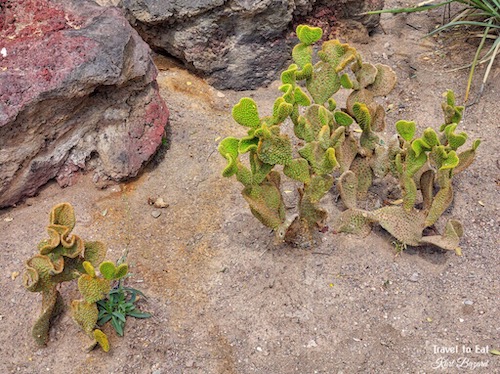
Crested Rabbit Ears (Opuntia microdasys var. pallida f. cristata, undulata) is a clustering succulent with unusual twisted pads bearing bright yellow clusters of glochids. It forms a dense shrub, to 40-60 cm high. We have spoken previously on Crested or Monstrous versions of cactus (Cereus peruvianus Monstrosus) and euphorbia Coral Cactus (Euphorbia lactea crest or cristata) seen at the Larco Museum in Lima. These are genetic malformations of the existing species. This one is equally difficult to name but is more stable than the preceding examples. Regardless of nomenclature, this is a genetic malformation with a pleasing aesthetic result.
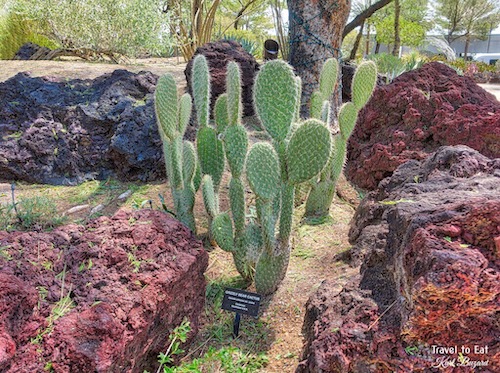
Also classed as a longer-spined variety of opuntia polyacantha, opuntia erinacea, the Mojave or grizzlybear prickly pear, is widespread in distribution and somewhat changeable in appearance; the main characteristic is the dense spines, which are white or pale yellow in color, reddish at the base, and between 1 and 7 inches in length (on the same plant); this variation gives the plant a shaggy, unkempt appearance. The shorter spines are quite thick, and some point downwards, while the longer ones (more noticeable on older pads) are thin, almost hair-like. The spines on this particular specimen are not as long as other photos I have seen, perhaps due to the ursina variety.
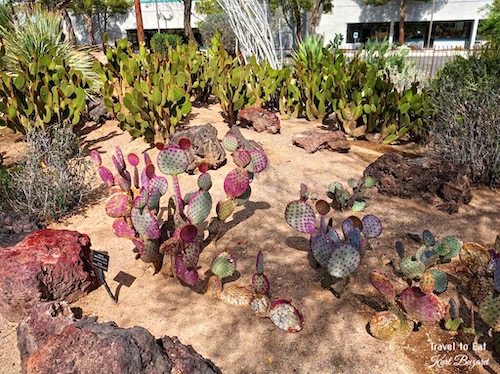
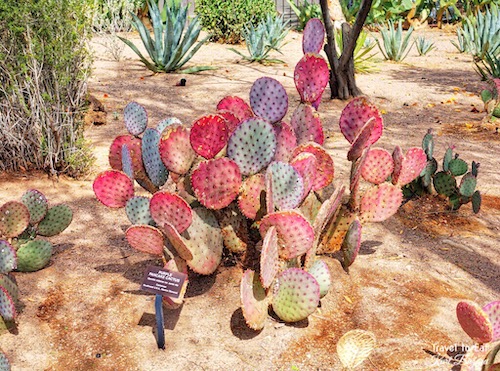
For the Santa Rita variety (Opuntia violaceae var. santa rita), it’s not about the fruit but rather the ornamental appeal. During stress from cold or drought, the palm-sized paddles turn a brilliant red-purple, adding a bright splash of color to the monotones of a dry garden. Different authorities disagree on the division of plants into Opuntia chlorotica, Opuntia violacea, Opuntia gosseliniana, Opuntia macrocentra, and perhaps others. To complicate the issue, there are numerous natural hybrids between species. There seems to be a lot of confusion as to the true identity of the ‘Santa Rita’ clone. And it is important to note that it is just a selected clone of a species (a cultivar), not a species in its own right. I have seen plants with the ‘Santa Rita’ label attached to purplish specimens of O. gosseliniana, O. macrocentra, O. chlorotica, and O. violaceae. From a botanists viewpoint, all of the above are probably synoymous taxa, just variable. Even some forms of engelmannii, and a plant of suspect rank called Opuntia “azureus”, have purplish segments at times, particularly when grown in full sun. Moreover I have seen miniature plants as well as giant tree pears given the name ‘Santa Rita’, just because they have very purple pads.
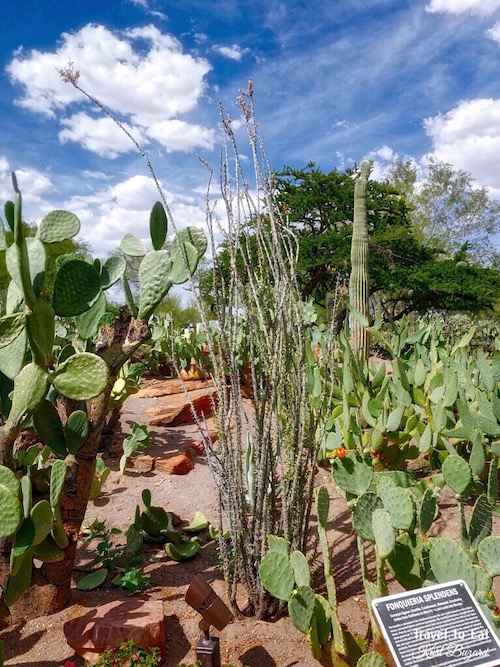
Fouquieria splendens (commonly known as ocotillo American Spanish, but also referred to as coachwhip, candlewood, slimwood, desert coral, Jacob’s staff, Jacob cactus, and vine cactus) is a plant indigenous to the deserts in the Southwestern United States. Ocotillo is not a true cactus. For much of the year, the plant appears to be an arrangement of large spiny dead sticks, although closer examination reveals that the stems are partly green. With rainfall, the plant quickly becomes lush with small (2–4 cm), ovate leaves, which may remain for weeks or even months.
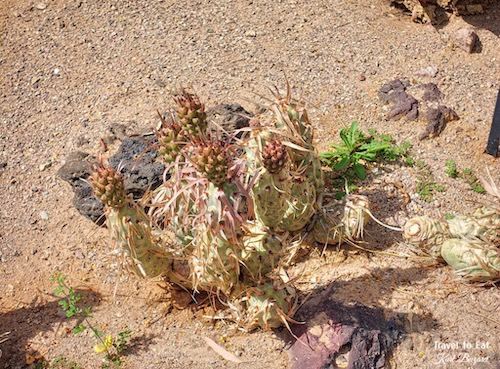
Tephrocactus articulatus is a species of cactus in the subfamily Opuntioideae of the Cactaceae family of plants. They usually grow branches up to one foot tall with white flowers. Propagation is usually through cuttings. Common varieties within the species include var. inermis (“Spruce cone cactus”) and var. papyracanthus (“Paper Spine Cholla Cactus”) which has paper-like thorns. Stem segments easily break away and will root without special treatment. Plants may also be grown from seeds.They originate in Argentina, but are cultivated in outdoor landscaping in warm desert climates such as Las Vegas.
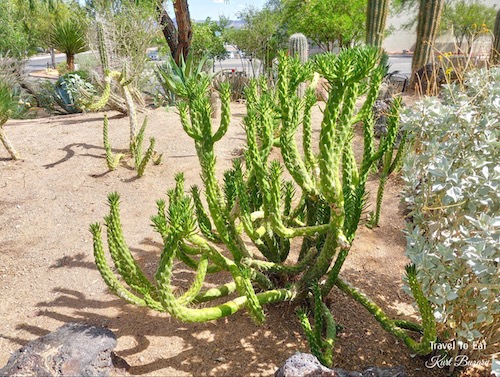
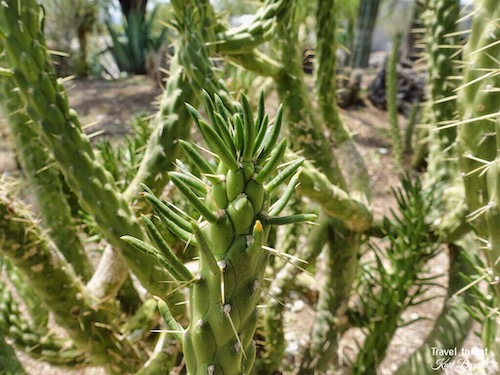
Austrocylindropuntia subulata is a species of cactus native to the Peruvian Andes. The name subulata comes from the Latin subulate, for awl-like, referring to the shape of the rudimentary leaves. It has the common names “Eve’s pin” and “Eve’s needle.” Eve’s-Pin Cactus, is a large tree-like cactus native to the higher elevations of Ecuador and Peru. In nature, the cactus lives at an elevation of 8000-12000 feet (2400-3600 m). Round cylindrical joints will reach up to 2 feet (60 cm) tall and 1.5-2.5 inches (4-6.5 cm) thick. Plants will reach about 13 feet (4 m) tall and 10 feet (3 m) wide. They are easily identified by their persistent, nearly cylindrical leaves. Leaves will reach about 3-5 inches (7.5-13 cm) long. New growth rarely has spines, but as the plants age they develop 1-3 inch (7.6 cm) long yellow spines per areole. This plant can be very deceptive in that it appears to be covered with long cylindrical succulent green leaves, however, behind these leaves are very sharp 3-inch long spines that are very painful if embedded in the skin. The plants are easy to grow and are hardy in the landscape in USDA zones 9-10.
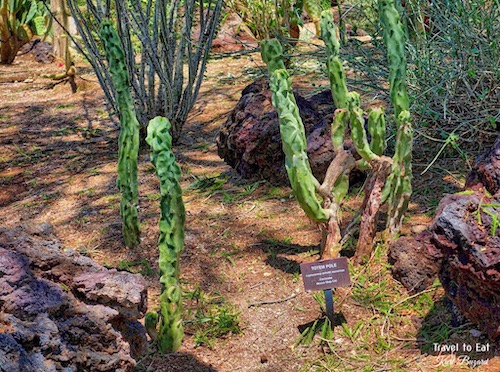
Lophocereus schottii is a slow-growing usually trunkless cactus that forms numerous tall, ascending, columnar stems which branch at the base in a candelabra-like arrangement. Stems have a waxy bloom on the surface and reach a height of 3-4 metres (but can grow up to 7m high) and are 10 to 12cm in diameter. They have five to nine widely-spaced ribs. One of the most distinguishing features is that the tips of the mature, taller stems are covered with about twenty sharp long, hairlike, grey bristles. L. schottii mostruosa is a naturally occurring mutation, which, although sterile, continues to survive in the wild. This growth form occurs naturally in at least two wild populations in a very soft sandy and gravely soil. In these two locations the plants persist because stem sections break off periodically and root along the sides to produce new plants.
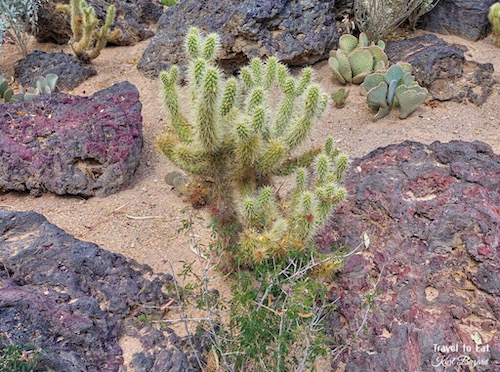
Cylindropuntia bigelovii, the teddy bear cholla, is a cholla cactus species native to Northwestern Mexico, and to the United States in California, Arizona, and Nevada. Cylindropuntia bigelovii has a soft appearance due to its solid mass of very formidable spines that completely cover the stems, leading to its sardonic nickname of “teddy bear”. Cholla cactus represent more than 20 species of the Opuntia genus (Family Cactacea) in the North American deserts. Cholla is a term applied to various shrubby cacti of this genus with cylindrical stems composed of segmented joints. These stems are actually modified branches that serve several functions, water storage, photosynthesis and flower production.
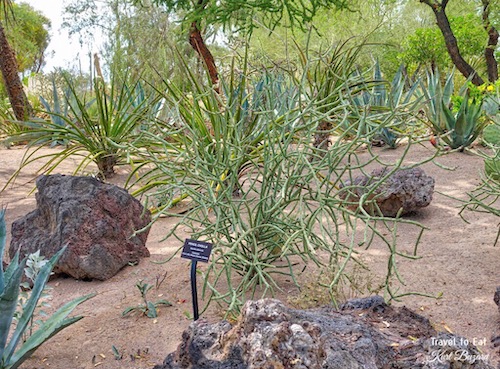
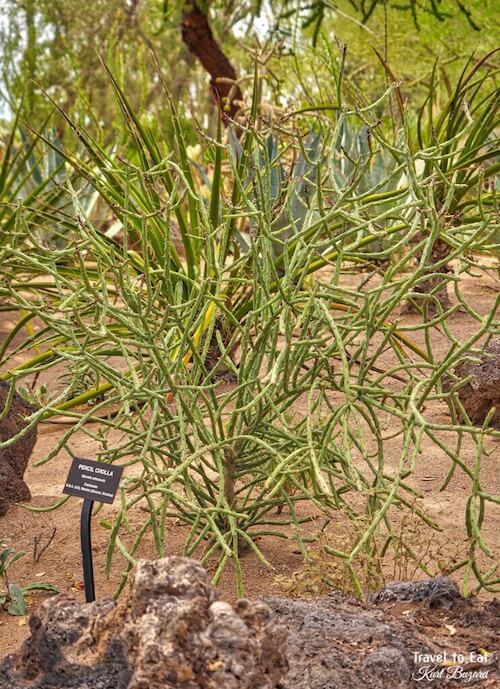
The Arizona Pencil Cholla, Cylindropuntia arbuscula is in a group of cacti sometimes referred to as “pencil chollas” and is similar to, and closely related to Christmas Cholla, Cylindropuntia leptocaulis and to Klein’s Pencil Cactus, Cylindropuntia kleiniae. Cylindropuntia was formerly treated as a subgenus of Opuntia, but have now been separated based on their cylindrical stems (Opuntia species have flattened stems) and the presence of papery epidermal sheaths on the spines (Opuntia has no sheaths). A few species of mat- or clump-forming opuntioid cacti are currently placed in the genus Grusonia.
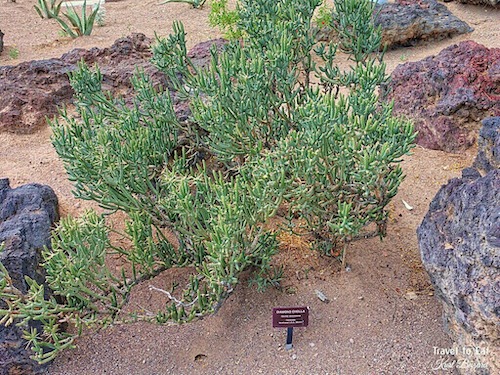
Diamond Cholla (Cylindropuntia ramosissima) is an upright, shrub-like cactus with very narrow stem segments and long, but sparse spines. The stem segments are short (to about 3-inches) and narrow (about 1/4-inch diameter). The spines tend to be solitary rather than clustered as in most cactus. The green stem color is clearly evident. Close-up views of the stem reveal lines in a diamond-shaped or crosshatch pattern. Flowers are small and yellow to reddish. Diamond Cholla usually is an uncommon component of vegetation communities on well-drained sandy, gravelly, and rocky soils on flats, bajadas, and moderate slopes into the lower mountains in the Lower Sonoran (Creosote-Bursage Flats) and Upper Sonoran (Mojave Desert Scrub) life zones. Occasionally, it can be found growing in relatively dense stands.
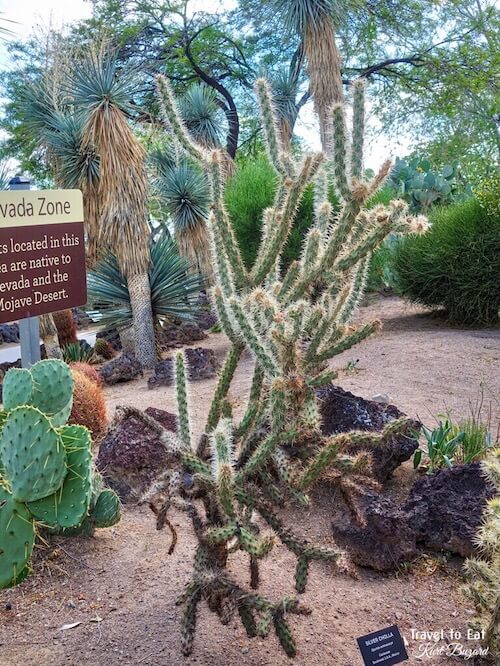
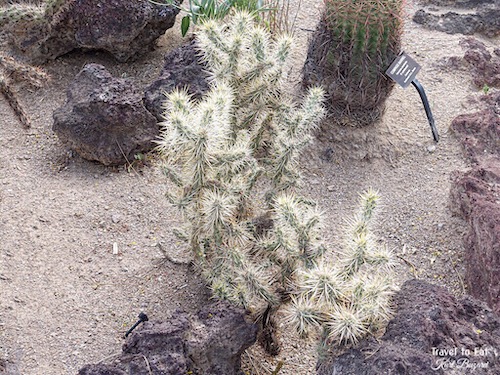
Cylindropuntia echinocarpa is a species of cactus known by the common names silver cholla, golden cholla, and Wiggins’ cholla. It was formerly named Opuntia echinocarpa. Silver Cholla (Cylindropuntia echinocarpa), also called Golden Cholla, is an upright cactus with joined, cylindrical stems. They often have a narrow upright trunk, but some populations are essentially prostrate (grow along the ground). Silver Cholla tends to have many short branches that are densely covered with yellowish or golden spines. The stem segments usually are shorter than 4 inches and tuberculated. The flowers are yellow-green and about 2.5-inches in diameter. The spines are covered with a papery sheath that can be plucked off. Silver Cholla superficially resembles Buckhorn Chollas, but Silver Cholla has short stem segments, while Buckhorn Cholla has long stem segments.
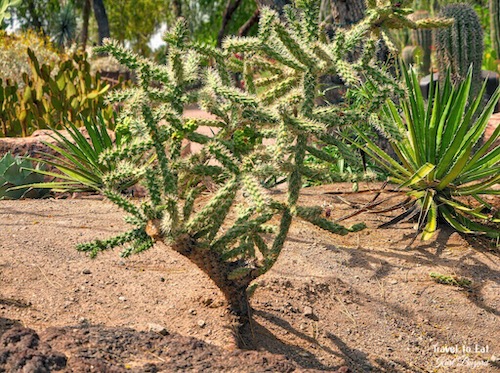
Cylindropuntia acanthocarpa, commonly referred to as buck horn cholla, is a cactus native to the deserts of southern California, southern Nevada, southwestern Utah and Arizona in the United States.The plant is found in the Mojave Desert and the Sonoran Deserts, including the Colorado Desert of California.
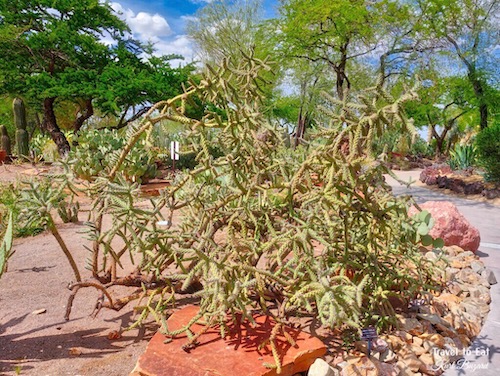
Cylindropuntia fulgida, the jumping cholla, also known as the hanging chain cholla, is a cholla cactus native to the Southwestern United States and Sonora. The “jumping cholla”, Opuntia fulgida, is a very spiny cactus, usually a shrub, but sometimes more like a tree, with a number of irregular, jointed branches bearing sharp-barbed spines that are painful and difficult to remove. Because the cholla’s 3- to 8-inch joints separate easily, they appear sometimes to “jump” to attack passersby. Also called the “chain fruit cholla” this variety grows to a height of 6 to 15 feet and a diameter of up to 8 feet. It is the largest of the cholla, other cholla specimens are usually much smaller.
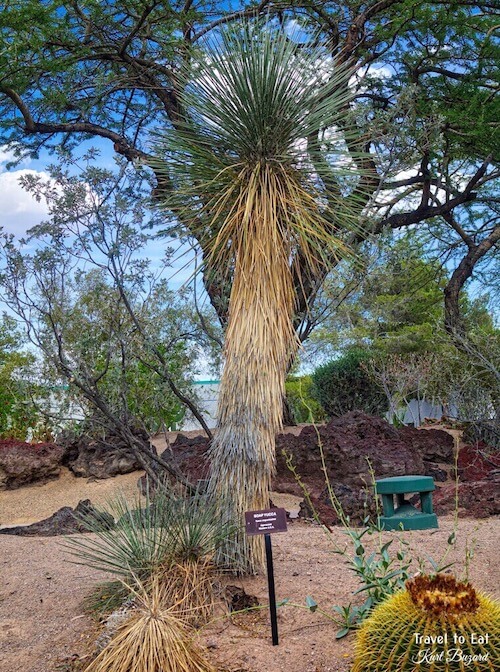
The soaptree yucca (Yucca elata) is one of the most characteristic plants of the Chihuahuan Desert. It is an abundant evergreen, palm-like shrub or small tree growing 10 to 18 feet high. The gray trunk, with a diameter of 6 to 12 inches, is slightly furrowed below and covered with dead leaves at the top. It is usually unbranched and has very long, narrow leaves. The grasslike leaves are flat and linear, growing 1 to 3 inches long and about 1/2 inch wide. The yellowish, leathery leaves have fine white threads along the edges and end in a sharp spine. It derives its name from the soapy material in its roots and trunks which made this plant a popular substitute for soap. Native Americans used the coarse fiber of the leaves for weaving baskets.
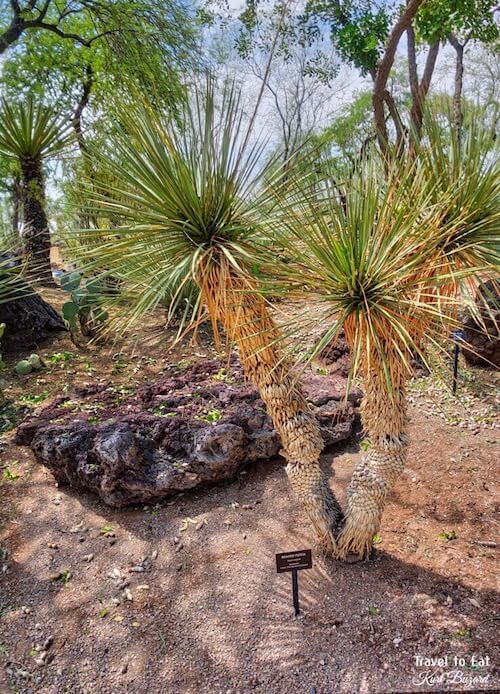
Yucca rostrata also called beaked yucca, is a tree-like plant belonging to the genus Yucca. The species is native to Texas, Chihuahua and Coahuila. There are some theories that these genera and some of the Agave were cultivated and cultivars developed by pre-columbian tribes of Mexico and central america. Many were useful and important both as landscape decoration as well as fiber development. Pre-columbian americas were far advanced in use of fiber technology over the old world. In fact, Cortez discarded his metal armor in favor of Aztec textile armour which was more effective against the obsidium points used on Aztec spear and arrow points. The obsidum would shatter and the glass chards worked its way into armour and did much damage that the bullet projectiles through the tough textile.
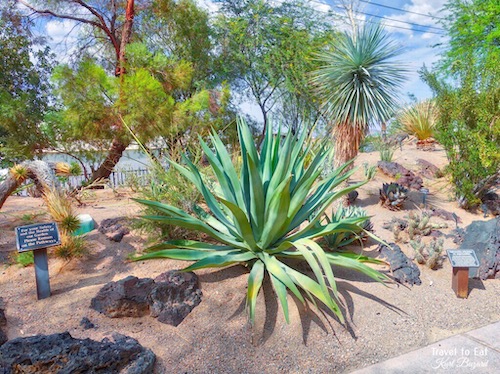
Yucca pallida, sometimes called Pale yucca, is a species of yucca native to Northern Mexico and parts of the blackland prairies of northern and central Texas, and notable for its light-colored leaves that range from a pale blue-gray to sage-green in color. Yucca pallida is known to hybridize with Yucca rupicola Scheele, which has a similar appearance, but whose leaves are more twisted and curved. This yucca looks very much like Agave attenuata but the edges of the leaves have a bumpy edge rather than the smooth edge of Agave attenuata.
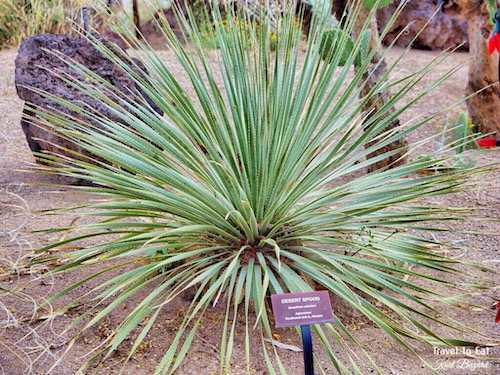
Dasylirion wheeleri (desert spoon, spoon flower, or common sotol) is a flowering plant native to arid environments of northern Mexico, in Chihuahua and Sonora and in the southwestern United States, in the Sonoran Desert in Arizona, and also in New Mexico and Texas. The alcoholic drink sotol, the northern cousin to tequila and mezcal, is made from the fermented inner cores of the desert spoon. It is the state drink of the Mexican states of Chihuahua, Durango, and Coahuila.
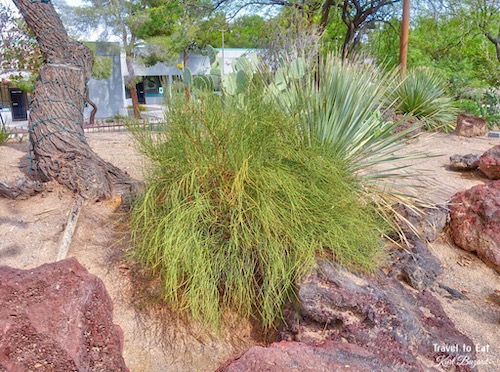
More than other North American Ephedra species, it is a significant forage plant. It is grazed upon by mule deer (Ococolius hemionus), pronghorn (Antilocapra americana), and Desert Bighorn Sheep (Ovis canadensis) as well as domestic sheep. Nevada ephedra was used for food and medicine by indigenous people and for tea by Mormons. Among the Zuni people an infusion of the whole plant, except for the root, taken for syphilis. They also use it to make a tea-like beverage.
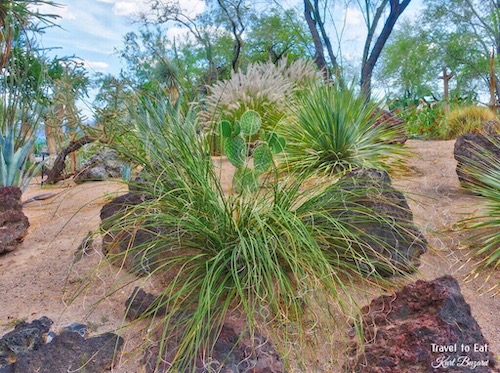
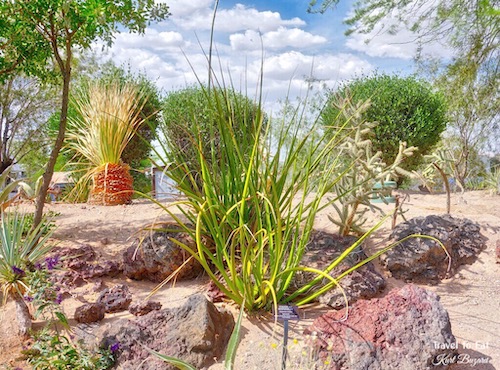
Coahuilan Hesperaloe or Giant Hesperaloe (Hesperaloe funifera) grows on rocky slopes and open plains in the Sonoran and Chihuahuan Deserts. Leaf color is yellow-green and can be approximately 2 inches wide and over 6 feet in length. Leaves have long curly hair like strings attached to the side margins. The rather stiff leaf tends to cascade toward the tip which adds to the attractive form of this increasingly popular species. There is much more at the Ethel M Cactus Garden, if you are in Las Vegas, you should visit. Please take the time to leave a comment.
References:
Ethyl M Botanical Garden: https://www.ethelm.com/category/visiting+the+factory/botanical+cactus+garden.do
Euphorbia: http://www.euphorbiaceae.org/pages/about_euphorbia.html
Encyclopedia of Cactus: http://www.llifle.com/Encyclopedia/CACTI/
Cactus Guide: http://cactiguide.com/
Optuntia: http://www.swcoloradowildflowers.com/Yellow%20Enlarged%20Photo%20Pages/opuntia.htm
Optinia Santa Rita: http://davesgarden.com/guides/pf/go/55374/
Optinia Santa Rita: http://www.latimes.com/home/la-lh-santa-rita-prickly-pear-20130909-story.html
Crested Rabbit Ears: http://davesgarden.com/guides/pf/go/70008/
Paper Spine Cactus: http://www.cactus-art.biz/schede/TEPHROCACTUS/Tephrocactus_articulatus/Tephrocactus_articulatus_papyracanthus/Tephrocactus_articulatus_papyracanthus.htm
Saguaro Cactus: http://www.desertusa.com/cactus/saguaro-cactus.html
Cholla Cactus: http://www.desertusa.com/cactus/cholla-cactus.html
Diamond Cholla: http://www.birdandhike.com/Veg/Species/Cactus/Cylind_ram/_Cyl_ram.htm
Barrel Cactus: http://www.desertusa.com/cactus/barrel-cactus.html
Lophcereus schotii: http://www.cactus-art.biz/schede/LOPHOCEREUS/Lophocereus_schotii/Lophocereus_schotii_mostruosus/lophocereus_schotti_mostruosa.htm
Beaked Yucca: http://davesgarden.com/guides/pf/go/59706/

